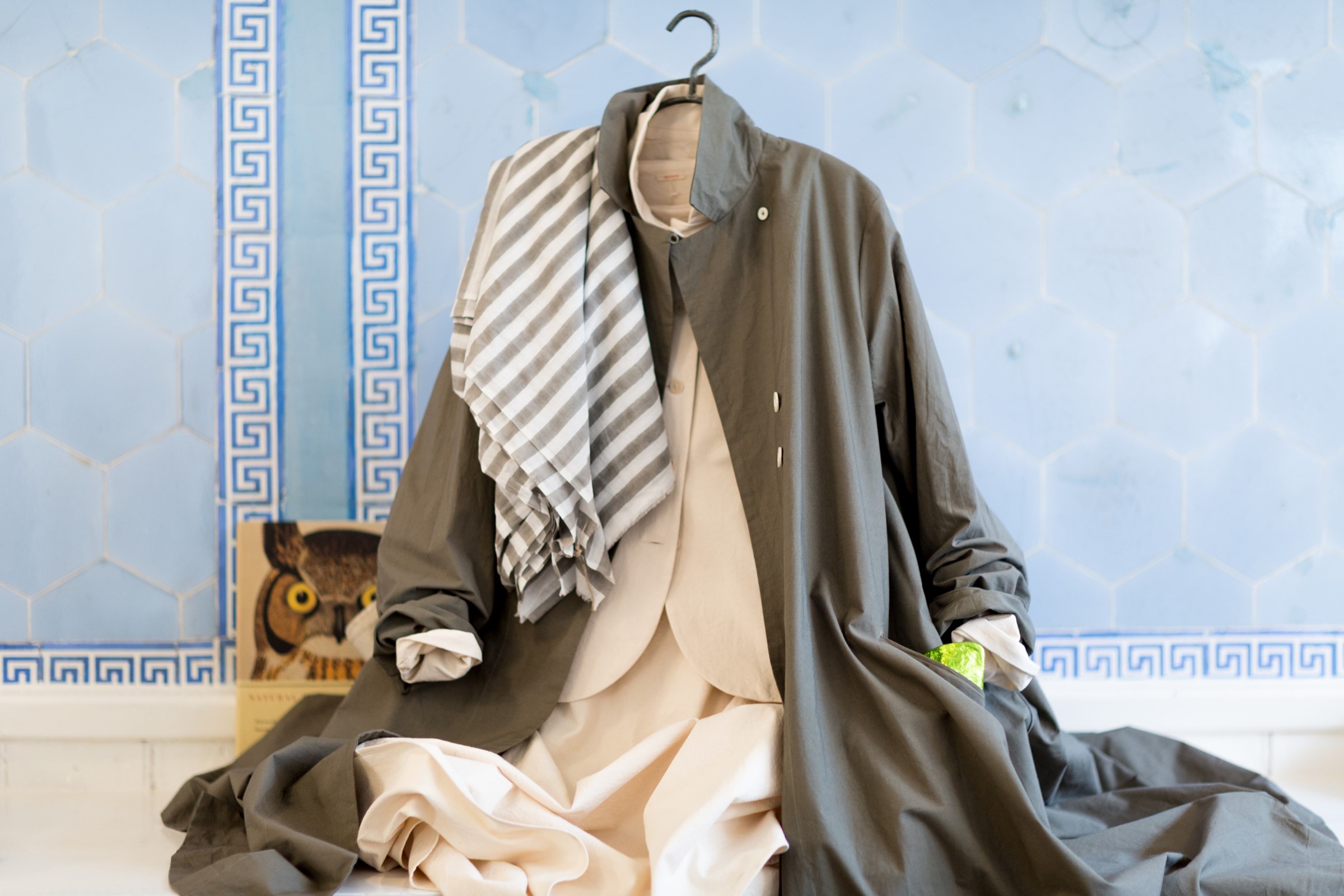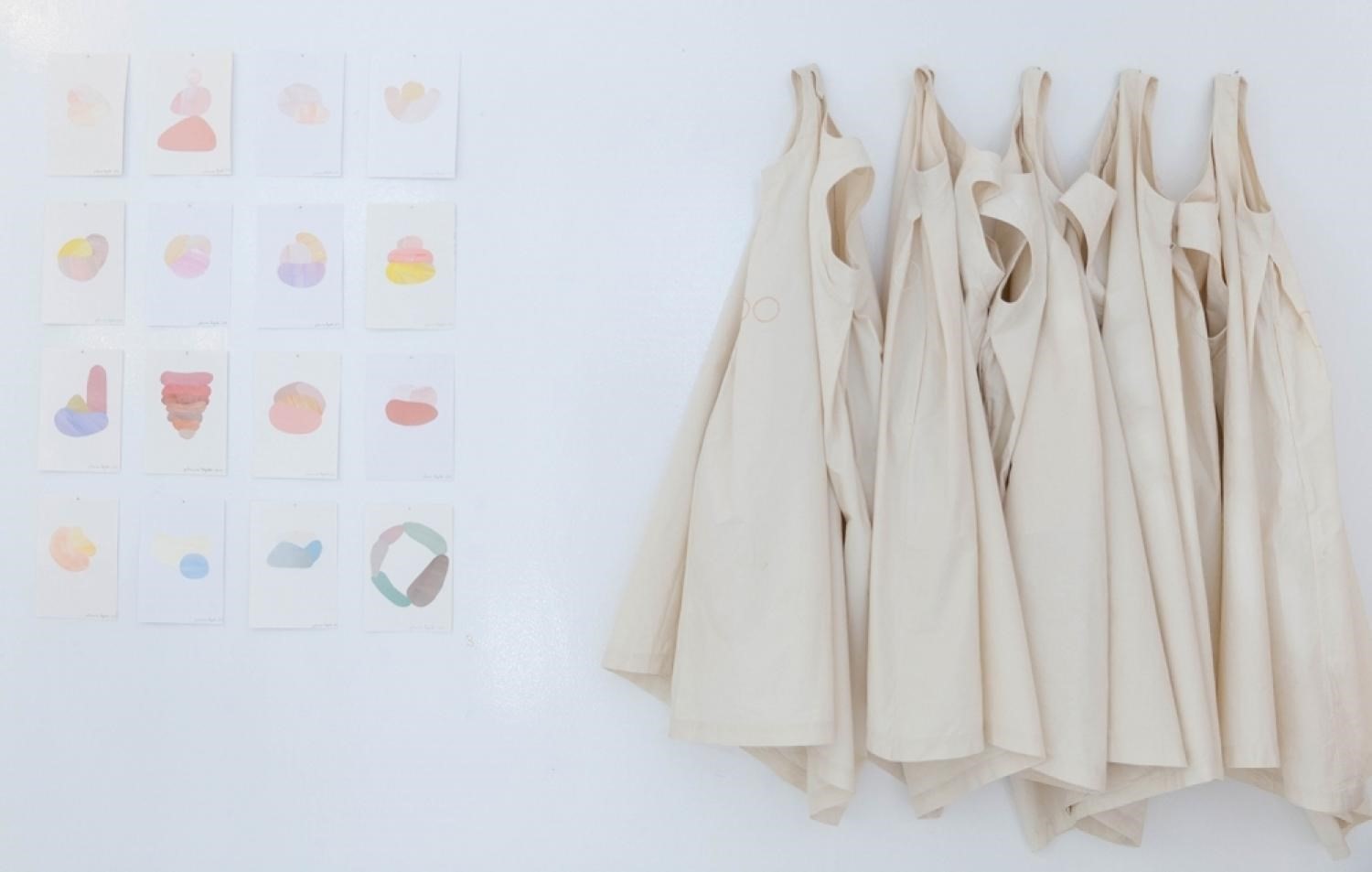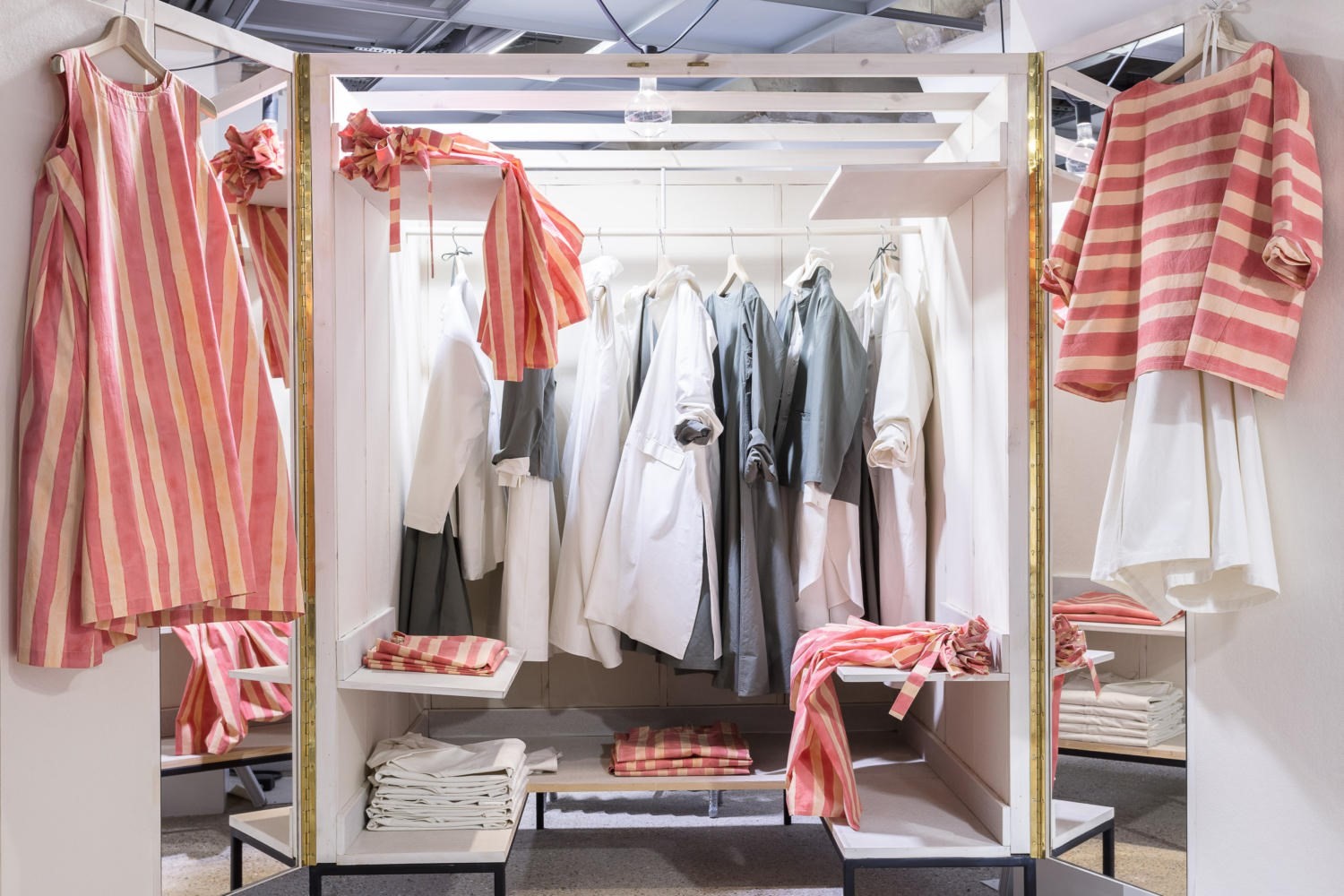You get the feeling that Maureen Doherty chooses you for an interview, rather than vice versa. After early attempts to arrange a meeting with her fell flat – emails date from last April – I began practising mindfulness about the whole thing and repeated to myself: I will not worry about things I cannot control (Maureen). Finally, around six months ago, one of her gatekeepers, the enigmatic young women who now run a significant portion of the business, approached me to say Maureen had enjoyed reading one of my pieces and would like to have tea at Egg on Kinnerton Street. Then things went quiet again and I almost gave up before lo and behold, Maureen left a voicemail and in early January, we shared hot brewed communion from white china cups while she smoked.
Doherty is at once outside the flow of time and strikingly contemporary in her approach to selling clothes. Egg is a former dairy and makes the most of the heel-repellent cobbles and forget-me-not blue ceramic tiles Doherty uncovered from latter veneers when she opened in 1994. Everything is whitewashed and the shop retains its barn doors – the kind cows could fit through – which are flung open in the summer. But I’m visiting in January during a cold snap and there’s no central heating. Pascale and Bella who work in the shop (and much besides) are swathed in cashmere scarves. Fittingly, an open wood fire burns in the wonky upstairs rooms where Doherty once lived with her daughter.

The shop uses proper furniture: wooden tables and chairs that have had interesting past lives. Clothes greet you like people as you walk in; entire outfits with shoes positioned where feet would be hang from metal hooks along the wall. When I visit, a set of all-white spring looks are being hung by Bella and Pascale, with scarves balled into cloth crania above the dresses. That current penchant for selling ceramics alongside clothing? Doherty has done it from the start, and in 1998 she gave the now-celebrated ceramic artist Edmund de Waal his first show in the shop. “I remember putting pots and frocks together because I studied ceramics. I had a show on with pots on the floors and had a golden retriever at the time who was stepping among them. Anita Besson of the Besson Gallery came in and went ‘arghhh!’, because she put ceramics on plinths.” Bowls, plates, bags, hats and folded up cloth appear sparsely throughout the network of rooms that make up the shop. The many brands rushing to create meaningful, analogue retail experiences should go and study Egg.
Doherty’s formative period was spent as Issey Miyake’s right-hand-woman. The pair met in Paris when she was 18 and working for designer Hans Metzen, building a retail empire with Valentino, Fiorucci and Miyake, among others. She was managing a buying budget of millions and had grown the business from one shop to 14 when, at 31, she’d had enough. “I threw my toys out of the pram, went to India – you could probably call it a nervous breakdown. I never wanted to go to another fashion show again. I’d had enough air kissing; I used to drive everyone mad because I’d wear old jeans to Valentino and sit on the floor. I was a rebel.” When Doherty came back a year later, single mother to her one-year-old daughter Jessie after a brief marriage, Miyake rang and asked her to run his own-brand Europe operation. She refused, but he persisted and won her over, but on her terms. “I worked on projects because I wanted to be with Jessie, not working till midnight. If he needed costumes for the ballet, or wanted a flat in Paris, or a book, I would find an architect, choose the flat, organise the exhibition. Issey never gave me a brief; he’d say to architects, ‘if it excites Maureen, it will work.’ He was like, ‘Do what you want!’”

Miyake’s spreadsheet-free approach, trusting Doherty’s instinct, shaped how she now runs Egg, where she has cultivated a distinctive visual culture more by example than decree. “Every time a fashion company is run by an accountant, things go wrong,” Doherty muses. After Miyake, Doherty studied ceramics and did a stint running Jigsaw, before launching Egg with then business partner, Asha Sarabhai, who had worked with Hermès and Prada. “The idea when I started was very clear: never to go to another fashion show; to avoid at all costs, and to work with makers,” Doherty recounts. When I ask what it was exactly she wanted to avoid (she didn’t specify), she replies, ‘them’. By ‘them’, she means the perpetual fashion merry-go-round of shows, parties and openings – “they all spend this time queuing in the rain, for what?!” she exclaims. “I like old clothes. I like clothes that live through generations. I sell what I like, and that was the beginning of Egg.”
Egg’s own label clothes (though there are no actual labels, as Doherty hates them) are based on costumes and uniforms that she updates, evolves and moves along with her pattern cutter Rika. One of the most enduring styles is based on the white uniform of a Rajistani milkman, which has been done in many different fabrics. Doherty’s exacting and distinct eye prefers the sort of oversized shapes that young designers like Molly Goddard (whose collection had a brief spell in Egg) and Simone Rocha have put on the catwalk in recent seasons. Doherty’s padded, sleeveless vests have a lot in common with Craig Green’s diamond-vests in stock at Dover Street Market. She also brings in other designers and nurturing new makers has always been integral to Egg – her spring buy includes a lot from Parisian brand Casey Casey.

Furthermore, despite her recoil from fashion hype, the queen of arguably the most hyped brand in the industry came knocking at her door, in the form of Rei Kawakubo. That Kawakubo wooed Doherty with repeated visits and finally flowers to convince her to do a shop-in-shop at Dover Street Market, conveys the extent of Egg’s influence. “She insisted,” Doherty recounts. “She came, she came she came and then one day she came with a bunch of daffodils and said ‘please come to Comme des Garçons’ and I said ‘Alright!’” And so Egg arrived in London’s Dover Street Market in 2011. However, while Doherty acknowledges that the young women who now largely run Egg are fans of DSM and that it has brought new people to Egg, she herself is less reverential. “For me to go to Comme des Garçons is like for me to go to Harrods; I’d rather scrub floors! I like going to Leila’s [a grocery shop in Shoreditch], I like going to the Rodin Museum, I like the basement of BHV in Paris where they sell nuts and bolts and screws. It just doesn’t interest me when things get to that point – it’s the growing of things that interests me. I love nurturing young designers and young makers. If I like them and what they do I will have it, and I will show it and if that seeds something, great.”
For Doherty, the interesting elements to being a shopkeeper concern the possibilities of what can happen in the space and the relationships cultivated through dressing people. “It’s about talking to somebody, finding common ground. I don’t care what anybody says, you can’t get that with a machine.” Some of her decisions would have most managers blanching: “Ten or 15 years ago I would empty the shop, because I wanted it empty for the day. I could do that, there’s a joy in that. Customers would come into an empty shop and say ‘there’s nothing here!’ I would say, yes it’s alright, sit down, have a cup of tea, watch the rugby, stroke the dogs – and I would know what they wanted anyway – ‘try that on!’ I like dressing people. I love it, I love the whole thing of it.”

She also takes pleasure in the challenge of converting unlikely candidates to her way of doing things. “There was this AWFUL woman last week, American. I went to the loo upstairs, she was upstairs and as I came out she said, ‘Hey you! You!’ She said ‘I am X, I am famous, I’ve got an hour. Dress me.’ And I looked at her and said ‘I’m really sorry I need an hour and a half.’ And she stayed – I knew I could get to her good part. It was all show, all bravado. She said ‘I want to try that on and that on’, and I said, ‘you’re welcome to try that on but you shouldn’t buy it. This is what you should be wearing and now she emails me saying, ‘I’m in St Tropez and every one is saying how wonderful I look, send me more clothes!’ But I can’t do that anymore, I can only do that sometimes and the girls have their own clients now, they do it their way, and that’s good.”
Doherty’s faith and confidence in the young women who work with her is relaxed and generous. They run the new website (an update on her previous system of sending her legions of international clients photos of everything ad hoc) and style collections too, developing their own version of Egg. “It started with me and the dogs and it’s them now. I’m like the old matron who walks around in grumps. No, really we do it together but I hate the idea of me growing old, the staff growing old, the clients growing old, and the clothes growing old. It’s really interesting to watch the growth of the girls and how they see Egg. I wanted something to create without ego, something daily. It’s only a frock, it’s not open heart surgery. If you like it, it’s you. If a frock makes you jump and smile, great!”
